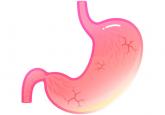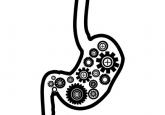Article
Recurrent abdominal pain and vomiting
A young man taking narcotic analgesics long-term has developed abdominal pain and vomiting. What is the cause?
Ahmad Muneer Sharayah, MD
Department of Internal Medicine, Monmouth Medical Center, Long Branch, NJ
Noor Hajjaj, MD
Faculty of Medicine, University of Jordan, Amman, Jordan
Ramy Osman, MD
Department of Internal Medicine, Monmouth Medical Center, Long Branch, NJ
Douglas Livornese, MD
Department of Pulmonary and Critical Care Medicine, Monmouth Medical Center, Long Branch, NJ
Address: Ahmad Muneer Sharayah, MD, Department of Internal Medicine, Monmouth Medical Center, 300 2nd Avenue, Long Branch, NJ 07740; drsharayah@gmail.com
A 40-year-old man with type 1 diabetes mellitus and recurrent renal calculi presented to the emergency department with nausea, vomiting, and abdominal pain for the past day. He had been checking his blood glucose level regularly, and it had usually been within the normal range until 2 or 3 days previously, when he stopped taking his insulin because he ran out and could not afford to buy more.
He said he initially vomited clear mucus but then had 2 episodes of black vomit. His abdominal pain was diffuse but more intense in his flanks. He said he had never had nausea or vomiting before this episode.
In the emergency department, his heart rate was 136 beats per minute and respiratory rate 24 breaths per minute. He appeared to be in mild distress, and physical examination revealed a distended abdomen, decreased bowel sounds on auscultation, tympanic sound elicited by percussion, and diffuse abdominal tenderness to palpation without rebound tenderness or rigidity. His blood glucose level was 993 mg/dL, and his anion gap was 36 mmol/L.
Computed tomography (CT) showed new severe gastric distention; a scan 11 months previously to look for renal stones had been normal (Figure 1). The patient’s presentation, physical examination, and laboratory and radiographic investigations narrowed the working diagnosis to gastric outlet obstruction or acute gastroparesis, but since CT showed no obstructing mass, the diagnosis of acute gastroparesis that coexisted with diabetic ketoacidosis was more likely.The patient was treated with hydration, insulin, and a nasogastric tube to relieve the pressure. The following day, his symptoms had significantly improved, his abdomen was less distended, his bowel sounds had returned, and his plasma glucose levels were in the normal range. The nasogastric tube was removed after he started to have bowel movements; he was given liquids by mouth and eventually solid food. Since his condition had significantly improved and he had started to have bowel movements, no follow-up imaging was done. The next day, he was symptom-free, his laboratory values were normal, and he was discharged home.
A young man taking narcotic analgesics long-term has developed abdominal pain and vomiting. What is the cause?
A stepwise approach can improve symptoms and quality of life while providing adequate nutrition.

A request for further information about the case described in the prior article.

The authors supply further pertinent information about the case described.

